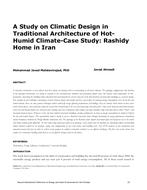Click here to purchase
Most design methods contain a forward framework, asking for primary specifications of a building to generate an output or assess its performance. However, architects urge for specific objectives though uncertain of the proper design parameters. Deep Learning (DL) algorithms provide an intelligent workflow in which the system can learn from sequential training experiments. This study applies a method using DL algorithms towards generating demanded design options. In this study, an object recognition problem is investigated to initially predict the label of unseen sample images based on training dataset consisting of different types of synthetic 2D shapes; later, a generative DL algorithm is applied to be trained and generate new shapes for given labels. In the next step, the algorithm is trained to generate a window/wall pattern for desired light/shadow performance based on the spatial daylight autonomy (sDA) metrics. The experiments show promising results both in predicting unseen sample shapes and generating new design options.
Citation: ASHRAE/IBPSA-USA Bldg Simulation Conf, Sept 2020
Product Details
- Published:
- 2020
- File Size:
- 1 file , 930 KB
- Product Code(s):
- D-BSC20-C065


